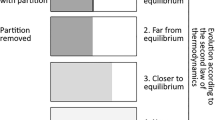Abstract
A numerical measure for “evidence” is defined in a probabilistic framework. The established mathematical concept of information or entropy (as defined in ergodic theory) can be obtained from this definition in a special case, although in general information is greater than evidence. In another, somewhat complementary, special case a numerical measure for “surprise” is derived from the definition of evidence. Some applications of the new concept of evidence are discussed, concerning statistics in general and the special kind of statistics performed by neurophysiologists, when they analyze the “response” of neurons, and perhaps by the neurons themselves.
Similar content being viewed by others
References
Billingsley, P.: Ergodic theory and information. New York: Wiley 1965
Gerstein, G.L., Mandelbrot, B.: Random walk models for the spike activity of a single neuron. Biophys. J.4, 41–68 (1964)
Gerstein, G.L., Perkel, D.H.: Mutual temporal relationships among neuronal spike trains. Biophys. J.12, 453–473 (1972)
Hebb, D.O.: The organization of behaviour. New York: Wiley 1949
Holden, A.V.: Models of the stochastic activity of neurones. Berlin, Heidelberg, New York: Springer 1976
Legéndy, C.R.: Three principles of brain function and structure. Int. Neurosci.6, 237–254 (1975)
Marr, D.: Philos. Trans. R. Soc. London Ser. B176, 161 (1970)
Marr, D.: Philos. Trans. R. Soc. London Ser. B262, 23 (1971)
Palm, G.: A common generalization of topological and measure-theoretic entropy. Société Mathématique de France, Astérisque40, 159–165 (1976)
Palm, G.: Entropy for dynamical systems. Fundação Universidade de Brasilia. Trab. Mat.151, 1–22 (1979)
Pfaffelhuber, E.: Learning and information theory. Int. J. Neurosci.3, 83–88 (1972)
Schlögl, F.: On stability of steady states. Z. Phys.243, 303–310 (1971)
Shannon, C.E., Weaver, W.: The mathematical theory of communication. University of Illinois Press 1959
Author information
Authors and Affiliations
Rights and permissions
About this article
Cite this article
Palm, G. Evidence, information, and surprise. Biol. Cybern. 42, 57–68 (1981). https://doi.org/10.1007/BF00335160
Received:
Issue Date:
DOI: https://doi.org/10.1007/BF00335160




